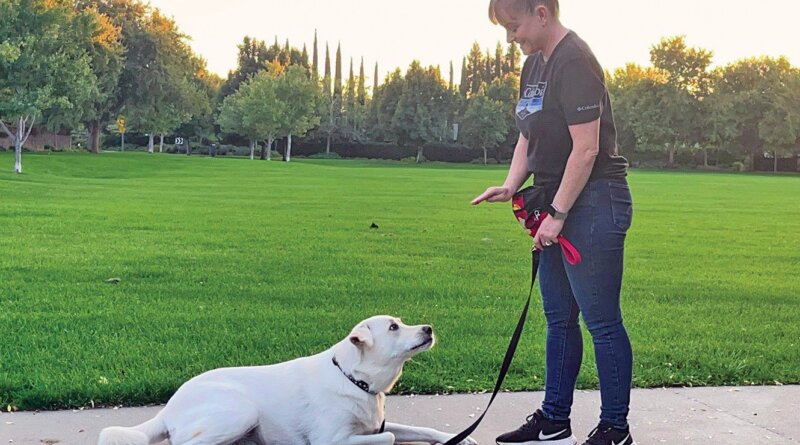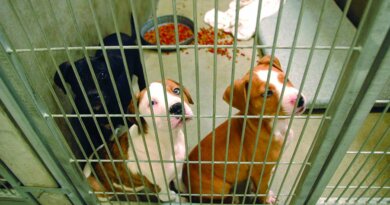Dog Training Basics: How to Teach a Cue
While our dogs are born with all sorts of natural canine inclinations – like searching out food, investigating scents, romping with friends – “listen to words from humans” is not part of their default program. That’s one they have to learn, from us. With the right kind of teaching, responding to your cues will become a dog’s go-to choice because it is the most reliable route to the things he wants.
Commands vs. Cues
Sometimes folks contact me saying their dog seems to be difficult to train. Then I show up and find that – with the best of intentions – they’re “commanding” their confused dog to DOWN! and LEAVE IT! in a big, scary voice. Rather than learning, the dog is intimidated and shuts down.
While old-fashioned dog training was driven by that kind of voice and a forceful “do it or else” approach, today we know that a more positive teaching style works better in the long run. To reflect that shift, WDJ along with much of the industry now uses the term “cue” rather than “command.” A cue is a signal to your dog that she has an opportunity to earn something she wants with the right response.
Teach Cues in This Order
Generally, the easiest way to begin teaching behaviors is by using a food lure. Here’s what that looks like. (Note that this stuff seems awfully complicated when it’s written out, but it’s really not.)
- START WITH NO CUE. Folks always want to start by saying the cue word, but if you keep repeating a word that’s currently meaningless to your dog, she might end up associating it with the wrong thing. (“Oh, I guess ‘sit’ must mean that kitty cat who just walked by.”)
- USE A LURE. Lure your dog’s body into position with a nugget of food that you keep just in front of his nose. Move s-l-o-w-l-y so the dog’s body can easily follow. (The most common mistakes are keeping food too far from the nose and/or moving it too quickly.) The moment the dog’s body is in the right spot, create a marker sound (more on that next) and pop the treat into your dog’s mouth.
- ADD THE VERBAL CUE. Once you can reliably lure the behavior, you can start saying the cue word as you do that. Now, the dog links that correct body position with the appropriate cue word.
- CHANGE THE LURE TO A HAND SIGNAL. Once this is all going swimmingly – your pup is offering that behavior about four out of five times – give the verbal cue as you mimic the luring motion with an empty directing hand. Ideally pup performs exactly as he has been, and you deliver that reward just as quickly, except from the other hand. The dog learns that following an empty hand works just as well. Now you’re using a hand signal.
- MAKE THE HAND SIGNAL SMALLER. As the dog catches on, the hand signal that began as a replica of the luring motion becomes smaller and smaller. For example, where you previously used a dramatic finger moving all the way to the ground to signify a down, you can now just do a quick point.
- DROP THE HAND SIGNAL. Sometimes people tell me in a very impressed tone that their brother-in-law’s dog follows hand signals without him saying anything! I don’t want to break the spell, so I keep it to myself that yeah, that’s easier. Dogs naturally pay attention to body language; it’s much harder to teach them to respond to our verbal language.
To do that, once we have a very minimized hand signal, we use timing to remove it entirely. We say the cue, and rather than immediately giving the hand signal, we wait a second to see if pup processes what we’ve just asked. No? Then give that signal.
Try again, with that little delay between the verbal cue and the hand signal. One of these times, your pup is going to do the thing you asked with no extra help from your body language. (Now go brag to your brother-in-law!)
Choose Just a Few Cues to Teach Your Dog at First
Remember that what you’re really teaching at first is the whole concept of training. Once your dog gets the idea that this is a fun new game where you’ll be guiding her into doing things – and she gets prizes when she gets it right – she’ll be all in.
Here’s my first-week list of (usually) easy-to-learn things:
- Name = Dog makes eye contact with human
- Sit = Dog’s bum touches floor
- Touch = Dog’s nose touches hand
- Find It = Dog searches floor for kibble
- Come! = Dog zooms to human for amazing treat
I encourage folks to spend a week getting those behaviors nice and solid, but it turns out that’s a big ask because humans are always in a rush. We all want to show off a 20-foot “stay” and a “leave it” in front of a mouth-watering bone!
Try to resist hurrying. Let’s show our dogs that it’s easy for things to work out well for them here on Planet Human. Let your dog feel like a superstar at the first five cues before you move onto the next tier of challenges.
Name = Dog makes eye contact with human Sit = Dog’s bum touches floor Touch = Dog’s nose touches hand Find It = Dog searches floor for kibble Come! = Dog zooms to human for amazing treat I encourage folks to spend a week getting those behaviors nice and solid, but it turns out that’s a big ask because humans are always in a rush. We all want to show off a 20-foot “stay” and a “leave it” in front of a mouth-watering bone! Try to resist hurrying. Let’s show our dogs that it’s easy for things to work out well for them here on Planet Human. Let your dog feel like a superstar at the first five cues before you move onto the next tier of challenges.
The Marker: Click Or “Yesss!”
If you’ve ever tried to learn something that feels very foreign to you – and you really had no idea if you were getting it or not – you’ll appreciate the beauty of what’s become known as “clicker training.” This is where you use a clear, concise sound to mark the exact moment your dog got it right.
The concept came from marine mammal training, where behaviorists used whistles to tell mid-air dolphins, “YES! That higher jump is exactly what we were looking for, and as soon as you swim to the side you’ll get a fish.” That whistle turned into a clicker for the dog world, and decades later, the Clicker Expo is the largest dog-training gathering in the world. Why? Because using a marker speeds learning.
Mind you, most of my beginning clients don’t love using the clicker, and I get it. We need a hand for the leash, a hand for the hand signal, a hand for dispensing treats, and now a hand for the clicker? It’s a challenge, and I don’t want that physical awkwardness to get in the way of a love of training, so I start with a different but almost as effective marker: the word “Yesss!” delivered in such a way that it is very distinct, clipped, and unmistakable.
Your mission is to learn to deliver that marker with perfect timing. Do it the very second your dog’s bum hits the floor in a “sit,” or nose bumps your hand in a “touch.” A treat always follows the marker. Soon enough, your pup is loving the sound of that marker, because it’s become a predictor of the reinforcer (the treat). At that point, the “Yesss!” has become what’s called a “conditioned reinforcer” and now carries power of its own. Now you can make your dog feel amazing the second he gets something right and hears that sound.
In contrast, if you didn’t mark that moment, you might be fumbling in your treat bag for a reward and by the time you deliver it (the moment the dog will remember) he’s no longer in that great sit.
It’s worth working on the timing of this; you’ll need to practice. I have a trainer friend who has his clients practice clicking (or saying “Yesss!”) the moment he bounces a tennis ball. You know what that teaches them? This is indeed something that needs practice! So practice your marker, and once you are great at giving instantaneous feedback, watch your dog suddenly seem like a genius.
For me, the marker technique is critical when I’m teaching something new, and I will drop the click or the “Yesss!” once the behavior is fluent. The point of the marker is to clarify exactly what’s being asked, and that kind of precision is no longer needed once the dog knows.
Moving to Intermittent Reinforcement
One of the big misconceptions about rewards-based positive reinforcement training is that you can’t ask your dog to do anything unless you have a cookie in your hand. That would be a legitimate gripe, if it were true!
But it’s not.
Once a pup is reliably succeeding at a certain cue, it’s important to move to something called “intermittent reinforcement,” which essentially means there’s no longer a treat every time . . . but there’s one often enough to keep your dog playing the lottery.
This is a critical step in training that first-timers sometimes miss. Folks get stuck in the mindset of Class #1 in Puppy 101, where in fact we give treats out with abandon, for every little look, touch, sit, and spin! In that earliest of phases we are seeking to build the strong “aha” moment where the pup deeply internalizes the idea that listening for a cue and responding with a behavior is the surest way to get stuff that makes them happy.
Once that light bulb has gone on, however, it’s time to move to the next big idea, which is essentially the lottery concept: You gotta play to win! We want to build into our pups the understanding that just because they didn’t get rewarded for one particular “down” it doesn’t mean the whole system is no longer in operation. It just means you have to keep trying and one of these times there’ll be a reward. Slowing the faucet builds resilience and turns your pup into one who will keep trying. He experiences an initial no-cookie moment, and comes out the other side to find . . . an eventual cookie!
I find the easiest way into this transition is to start asking for two-fers and three-fers. A puppy in her first training class gets a click and a treat for a sit, and right after that, a click and a treat for a touch. A week later, when the pup is now reliably performing both of those cues in class, we move into a two-fer: We ask for a sit and immediately after that ask for a touch. Pup gets a click and a treat after the second behavior. Or after the third behavior in a touch-spin-sit three-fer.
“Ack!” you’re thinking! “No click after that first behavior? But will my pup think she’s suddenly doing it wrong?” I promise if you group those cues together closely enough your pup won’t have time to be disturbed about that. However, this is where a new sound, an informative marker, could come in handy. You can use a quick “good,” or “mm-hmm” to confirm your pup did something right. It doesn’t promise a treat, but it gives affirmation.
Moving to intermittent reinforcement has the counterintuitive effect of making dogs more focused rather than less. When the faucet turns off a bit the learner will try a little harder to make it turn back on: more intense eye contact, a straighter sit, a quicker down. Essentially: “Huh. No treat? Let me try that again.”
At various points in your life with your dog, you’ll be at different reward schedules for different cues. Very quickly, you’ll be able to move to an intermittent schedule for a handful of the cues that are easiest for your pup. But it’s typical that you might be struggling with, say, “down” – so pup gets a click and a treat every single time those elbows hit the ground. Why? Because clear, consistent reinforcement of a behavior builds that behavior. Once it’s easy for your pup, there’s no longer a need to provide that bright neon sign.
When Can You Stop Giving Treats?
To Adjust Difficulty, Use The Three D’s: Distance, Duration, and Distraction
There are three factors that can either increase or decrease the difficulty of the behavior you are teaching your dog. Trainers often call them the three D’s: Distance, Duration, and Distraction.
If your dog seems to be having trouble learning something, ponder whether you can make one of the three D’s easier. Did you throw the treat too far away when you tried “Find It”? (Reduce the distance!) When you asked for a stay, did you wait so long to reward that your dog gave up? (Reduce the duration!) Were you surprised that your dog didn’t offer her usually easy sit when the neighbors were over? (Reduce the distractions!)
If you scale back your D’s, you’ll likely get to a place where your pup can more easily succeed. Start there, and build the skill.
On the other hand, if you are getting a little bored and think you have nothing left to teach, think about increasing one or more of the three D’s. There’s always a way to make a cue/behavior more challenging:
- Try giving your dog a cue to sit when he’s on the far side of the room, or 50 feet ahead of you on a trail (increasing the distance).
- Ask your dog to hold his down/stay for the length of your weekly call with a relative or while you answer an email or two (increasing duration).
- Try giving your dog a cue while you’re lying down or doing jumping jacks (increasing distractions).
It’s nice to have a dog who always sits when you give her the cue while standing in front of her in the kitchen where you always train. But it’s far more helpful for your life (not to mention more interesting and fun) if you “proof” that behavior by gradually varying the 3 D’s. Imagine how cool it would be if your pup would easily listen in the middle of a crowded barbeque as you yelled “Stay!” from across the yard when a guest mistakenly left a gate wide open.
Using rewards-based, relationship-building methods isn’t brain surgery, but it’s also not as easy as you might think. Investing a little time in refining your technique will save you (and your dog) lots of frustration.
Inevitably, this question arises: “So when can we stop with the treats altogether?” It is, in a certain sense, a logical question. After all, if we’re scaling back to intermittent reinforcement, it seems we’re heading in the direction of zero.
Ah, but we are not.
We often ask dogs to do things – for our own convenience – that:
- They would not do on their own.
- Are not intrinsically rewarding to them.
- Are often, in fact, against their natural instincts and desires.
The science of learning theory says that none of us does anything for very long unless it is somehow reinforcing/rewarding/in our own best interest. Despite Lassie and the mountains of dog myths in the back of our collective mind, that is true for dogs as well.
A promise of a little morsel of food every now and then is not too much to ask to get our dogs – the puppies we’ve kidnapped from their own culture – to want to do the weird stuff that’s prized in our culture. Right?
So, nope. There’s never a day when we stop rewarding. As time goes on, you’ll find that it becomes second nature to incorporate powerful real-life rewards into your daily routine with your dog; for example, when the nice “sit” earns an open car door and a promise of adventure, rather than a cookie. Those, along with warm praise, may become your primary way of rewarding your dog once he’s learned the basics. But do the food rewards ever come to an end? No.
And honestly, as my dear old dogs have aged and moved onto the heavenly branch of our pack, I’m happy for every sweet moment where I gave them a dried liver cube just for that cute little spin they had learned long ago.





